Abstract
OBJECTIVE--To determine whether diabetic patients admitted with acute myocardial infarction have impaired fibrinolytic activity due to raised plasminogen activator inhibitor compared with non-diabetic patients. SETTING--A district general hospital. PATIENTS--90 non-diabetic and 38 diabetic patients admitted with acute myocardial infarction. RESULTS--Both plasminogen activator inhibitor activity and antigen were significantly higher in diabetic than in non-diabetic patients (24.7 (6.8) v 18.5 (6.8) AU/ml; p = 0.0001 and 64.2 (range 13.1 to 328.8) v 38.5 (range 10.9 to 173.7 ng/ml; z = 3.3; p = 0.0008) with a positive correlation between activity and antigen (rs = 0.51; p = 0.0001). In both groups, activity and antigen concentrations were significantly higher than in diabetic and non-diabetic subjects without coronary artery disease (p = 0.002 to 0.0001 for each comparison). Plasminogen activator inhibitor activity correlated significantly with admission plasma glucose (r = 0.32; p = 0.0001), glycated haemoglobin (r = 0.32; p = 0.0001), admission plasma insulin (rs = 0.48; p = 0.001), and Killip grade of heart failure both on admission (rs = 0.27; p = 0.001) and on discharge (rs = 0.22; p = 0.006), but not with cumulative creatine kinase MB isoenzyme release (rs = -0.08). There were similar but weaker correlations between tissue plasminogen activator antigen and admission plasma glucose, glycated haemoglobin, and insulin. In 18 patients (12 non-diabetic and six diabetic) plasminogen activator inhibitor activity was measured between six and 12 months (8.3 (1.6)) after the acute infarct and remained similar to activity on admission (24.8 (1.9) AU/ml (NS) for diabetic and 17.9 (6.9) AU/ml (NS) for non-diabetic patients) and was still significantly higher in diabetic than in non-diabetic patients (p = 0.007). CONCLUSION--These results show that diabetic patients have higher plasminogen activator inhibitor activity than non-diabetic patients both on admission with acute myocardial infarction and at follow up six to 12 months later. Raised plasminogen activator inhibitor activity may predispose diabetic patients to myocardial infarction and may also impair pharmacological and spontaneous reperfusion after acute myocardial infarction thus contributing to the poor outcome in these subjects.
Full text
PDF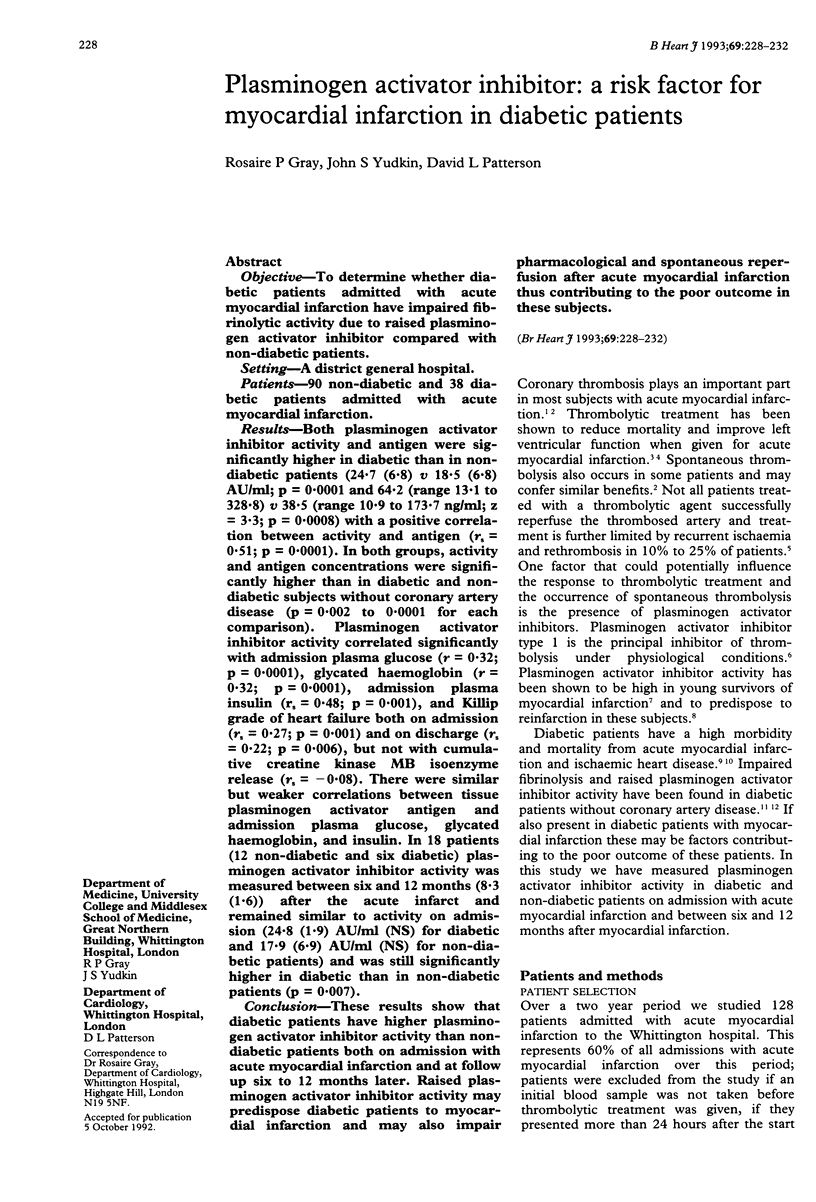
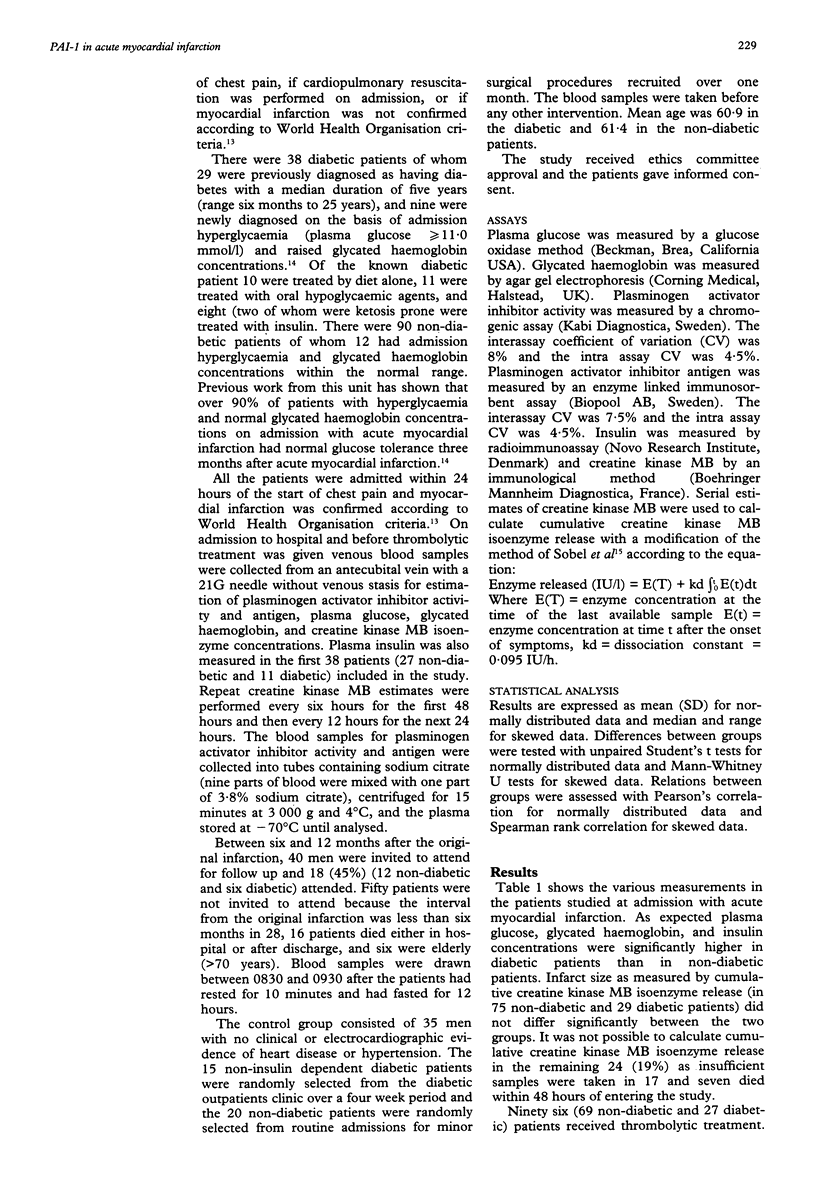
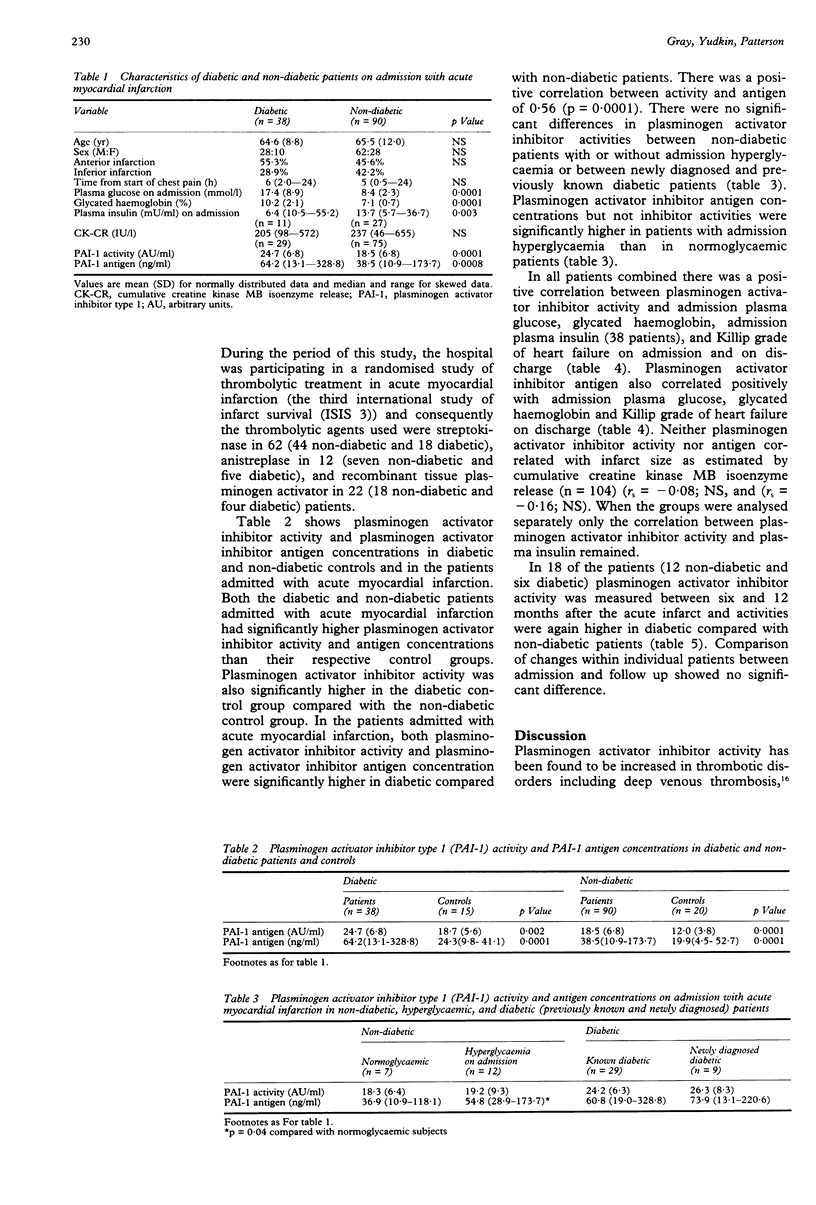
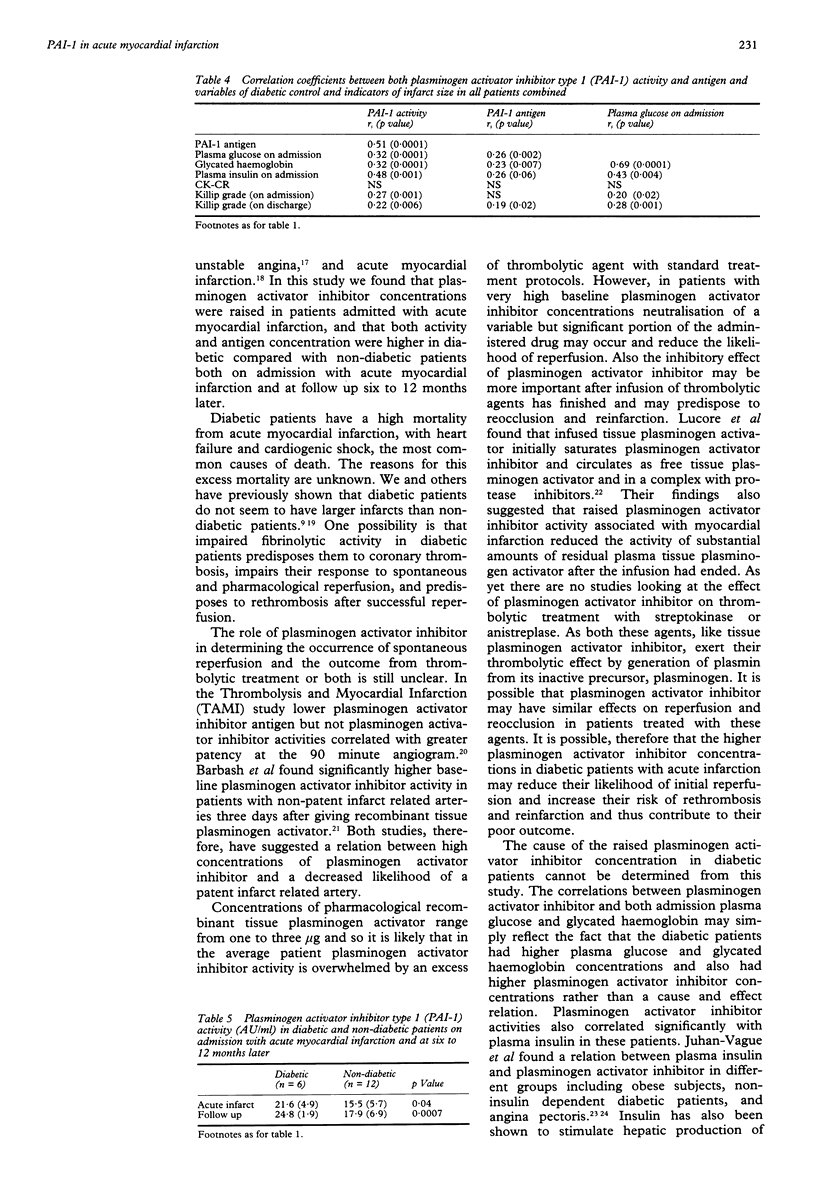
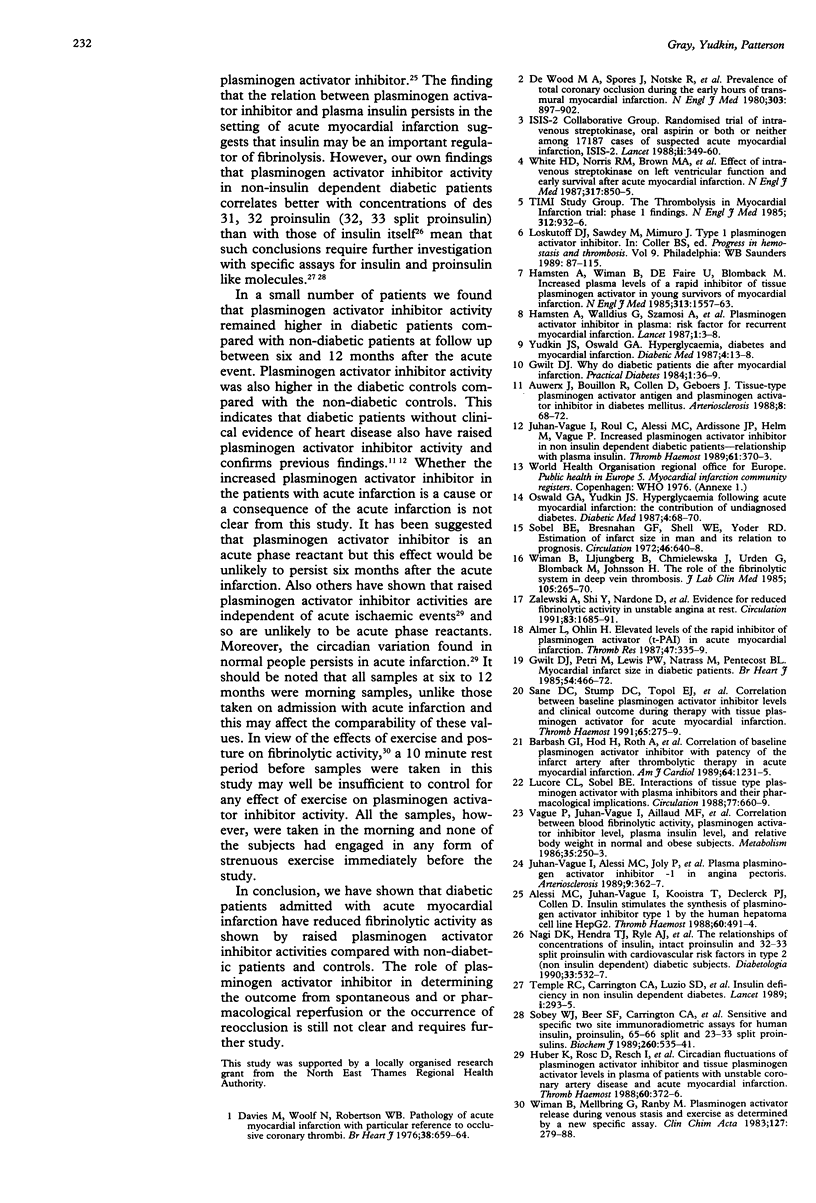
Selected References
These references are in PubMed. This may not be the complete list of references from this article.
- Alessi M. C., Juhan-Vague I., Kooistra T., Declerck P. J., Collen D. Insulin stimulates the synthesis of plasminogen activator inhibitor 1 by the human hepatocellular cell line Hep G2. Thromb Haemost. 1988 Dec 22;60(3):491–494. [PubMed] [Google Scholar]
- Almér L. O., Ohlin H. Elevated levels of the rapid inhibitor of plasminogen activator (t-PAI) in acute myocardial infarction. Thromb Res. 1987 Aug 1;47(3):335–339. doi: 10.1016/0049-3848(87)90147-2. [DOI] [PubMed] [Google Scholar]
- Auwerx J., Bouillon R., Collen D., Geboers J. Tissue-type plasminogen activator antigen and plasminogen activator inhibitor in diabetes mellitus. Arteriosclerosis. 1988 Jan-Feb;8(1):68–72. doi: 10.1161/01.atv.8.1.68. [DOI] [PubMed] [Google Scholar]
- Barbash G. I., Hod H., Roth A., Miller H. I., Rath S., Zahav Y. H., Modan M., Zivelin A., Laniado S., Seligsohn U. Correlation of baseline plasminogen activator inhibitor activity with patency of the infarct artery after thrombolytic therapy in acute myocardial infarction. Am J Cardiol. 1989 Dec 1;64(19):1231–1235. doi: 10.1016/0002-9149(89)90559-6. [DOI] [PubMed] [Google Scholar]
- Davies M. J., Woolf N., Robertson W. B. Pathology of acute myocardial infarction with particular reference to occlusive coronary thrombi. Br Heart J. 1976 Jul;38(7):659–664. doi: 10.1136/hrt.38.7.659. [DOI] [PMC free article] [PubMed] [Google Scholar]
- DeWood M. A., Spores J., Notske R., Mouser L. T., Burroughs R., Golden M. S., Lang H. T. Prevalence of total coronary occlusion during the early hours of transmural myocardial infarction. N Engl J Med. 1980 Oct 16;303(16):897–902. doi: 10.1056/NEJM198010163031601. [DOI] [PubMed] [Google Scholar]
- Gwilt D. J., Petri M., Lewis P. W., Nattrass M., Pentecost B. L. Myocardial infarct size and mortality in diabetic patients. Br Heart J. 1985 Nov;54(5):466–472. doi: 10.1136/hrt.54.5.466. [DOI] [PMC free article] [PubMed] [Google Scholar]
- Hamsten A., Wiman B., de Faire U., Blombäck M. Increased plasma levels of a rapid inhibitor of tissue plasminogen activator in young survivors of myocardial infarction. N Engl J Med. 1985 Dec 19;313(25):1557–1563. doi: 10.1056/NEJM198512193132501. [DOI] [PubMed] [Google Scholar]
- Hamsten A., de Faire U., Walldius G., Dahlén G., Szamosi A., Landou C., Blombäck M., Wiman B. Plasminogen activator inhibitor in plasma: risk factor for recurrent myocardial infarction. Lancet. 1987 Jul 4;2(8549):3–9. doi: 10.1016/s0140-6736(87)93050-9. [DOI] [PubMed] [Google Scholar]
- Huber K., Rosc D., Resch I., Schuster E., Glogar D. H., Kaindl F., Binder B. R. Circadian fluctuations of plasminogen activator inhibitor and tissue plasminogen activator levels in plasma of patients with unstable coronary artery disease and acute myocardial infarction. Thromb Haemost. 1988 Dec 22;60(3):372–376. [PubMed] [Google Scholar]
- Juhan-Vague I., Alessi M. C., Joly P., Thirion X., Vague P., Declerck P. J., Serradimigni A., Collen D. Plasma plasminogen activator inhibitor-1 in angina pectoris. Influence of plasma insulin and acute-phase response. Arteriosclerosis. 1989 May-Jun;9(3):362–367. doi: 10.1161/01.atv.9.3.362. [DOI] [PubMed] [Google Scholar]
- Juhan-Vague I., Roul C., Alessi M. C., Ardissone J. P., Heim M., Vague P. Increased plasminogen activator inhibitor activity in non insulin dependent diabetic patients--relationship with plasma insulin. Thromb Haemost. 1989 Jun 30;61(3):370–373. [PubMed] [Google Scholar]
- Loskutoff D. J., Sawdey M., Mimuro J. Type 1 plasminogen activator inhibitor. Prog Hemost Thromb. 1989;9:87–115. [PubMed] [Google Scholar]
- Lucore C. L., Sobel B. E. Interactions of tissue-type plasminogen activator with plasma inhibitors and their pharmacologic implications. Circulation. 1988 Mar;77(3):660–669. doi: 10.1161/01.cir.77.3.660. [DOI] [PubMed] [Google Scholar]
- Nagi D. K., Hendra T. J., Ryle A. J., Cooper T. M., Temple R. C., Clark P. M., Schneider A. E., Hales C. N., Yudkin J. S. The relationships of concentrations of insulin, intact proinsulin and 32-33 split proinsulin with cardiovascular risk factors in type 2 (non-insulin-dependent) diabetic subjects. Diabetologia. 1990 Sep;33(9):532–537. doi: 10.1007/BF00404140. [DOI] [PubMed] [Google Scholar]
- Oswald G. A., Yudkin J. S. Hyperglycaemia following acute myocardial infarction: the contribution of undiagnosed diabetes. Diabet Med. 1987 Jan-Feb;4(1):68–70. doi: 10.1111/j.1464-5491.1987.tb00833.x. [DOI] [PubMed] [Google Scholar]
- Sane D. C., Stump D. C., Topol E. J., Sigmon K. N., Kereiakes D. J., George B. S., Mantell S. J., Macy E., Collen D., Califf R. M. Correlation between baseline plasminogen activator inhibitor levels and clinical outcome during therapy with tissue plasminogen activator for acute myocardial infarction. Thromb Haemost. 1991 Mar 4;65(3):275–279. [PubMed] [Google Scholar]
- Sobel B. E., Bresnahan G. F., Shell W. E., Yoder R. D. Estimation of infarct size in man and its relation to prognosis. Circulation. 1972 Oct;46(4):640–648. doi: 10.1161/01.cir.46.4.640. [DOI] [PubMed] [Google Scholar]
- Sobey W. J., Beer S. F., Carrington C. A., Clark P. M., Frank B. H., Gray I. P., Luzio S. D., Owens D. R., Schneider A. E., Siddle K. Sensitive and specific two-site immunoradiometric assays for human insulin, proinsulin, 65-66 split and 32-33 split proinsulins. Biochem J. 1989 Jun 1;260(2):535–541. doi: 10.1042/bj2600535. [DOI] [PMC free article] [PubMed] [Google Scholar]
- Temple R. C., Carrington C. A., Luzio S. D., Owens D. R., Schneider A. E., Sobey W. J., Hales C. N. Insulin deficiency in non-insulin-dependent diabetes. Lancet. 1989 Feb 11;1(8633):293–295. doi: 10.1016/s0140-6736(89)91306-8. [DOI] [PubMed] [Google Scholar]
- Vague P., Juhan-Vague I., Aillaud M. F., Badier C., Viard R., Alessi M. C., Collen D. Correlation between blood fibrinolytic activity, plasminogen activator inhibitor level, plasma insulin level, and relative body weight in normal and obese subjects. Metabolism. 1986 Mar;35(3):250–253. doi: 10.1016/0026-0495(86)90209-x. [DOI] [PubMed] [Google Scholar]
- White H. D., Norris R. M., Brown M. A., Takayama M., Maslowski A., Bass N. M., Ormiston J. A., Whitlock T. Effect of intravenous streptokinase on left ventricular function and early survival after acute myocardial infarction. N Engl J Med. 1987 Oct 1;317(14):850–855. doi: 10.1056/NEJM198710013171402. [DOI] [PubMed] [Google Scholar]
- Wiman B., Ljungberg B., Chmielewska J., Urdén G., Blombäck M., Johnsson H. The role of the fibrinolytic system in deep vein thrombosis. J Lab Clin Med. 1985 Feb;105(2):265–270. [PubMed] [Google Scholar]
- Wiman B., Mellbring G., Rånby M. Plasminogen activator release during venous stasis and exercise as determined by a new specific assay. Clin Chim Acta. 1983 Jan 24;127(2):279–288. doi: 10.1016/s0009-8981(83)80012-6. [DOI] [PubMed] [Google Scholar]
- Yudkin J. S., Oswald G. A. Hyperglycaemia, diabetes and myocardial infarction. Diabet Med. 1987 Jan-Feb;4(1):13–18. doi: 10.1111/j.1464-5491.1987.tb00821.x. [DOI] [PubMed] [Google Scholar]
- Zalewski A., Shi Y., Nardone D., Bravette B., Weinstock P., Fischman D., Wilson P., Goldberg S., Levin D. C., Bjornsson T. D. Evidence for reduced fibrinolytic activity in unstable angina at rest. Clinical, biochemical, and angiographic correlates. Circulation. 1991 May;83(5):1685–1691. doi: 10.1161/01.cir.83.5.1685. [DOI] [PubMed] [Google Scholar]


